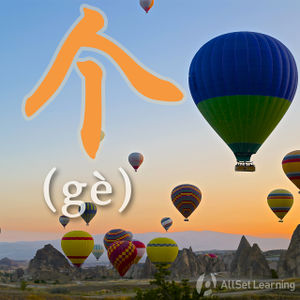Difference between revisions of "Measure word "ge""
| Line 18: | Line 18: | ||
<div class="liju"> | <div class="liju"> | ||
| − | * 一 <em>个</em> | + | * 一 <em>个</em> 球<span class="trans">one ball</span> |
| − | * 两 <em>个</em> 人<span class="trans">two people</span> | + | * 两 <em>个</em> 人<span class="trans">two people</span><span class="expl">use 两 not 二,look at [["Er" and "liang"]]</span> |
* 三 <em>个</em> 苹果<span class="trans">three apples</span> | * 三 <em>个</em> 苹果<span class="trans">three apples</span> | ||
| − | * | + | * 四 <em>个</em> 三明治<span class="trans">four sandwich</span> |
| + | * 五 <em>个</em> 星期<span class="trans">five weeks</span> | ||
| + | * 六 <em>个</em> 杯子<span class="trans">six cups</span> | ||
| + | * 十 <em>个</em> 男人, 七 <em>个</em> 傻, 八 <em>个</em> 坏<span class="trans">ten males, seven are fool, eight are bad.</span> | ||
* 八十 <em>个</em> 诗人<span class="trans">eighty poets</span> | * 八十 <em>个</em> 诗人<span class="trans">eighty poets</span> | ||
| + | * 一百 <em>个</em> 美女<span class="trans">one hundred beautiful girls</span> | ||
</div> | </div> | ||
| Line 30: | Line 34: | ||
If the number is one (1), you can omit it and use 个 by itself. This is equivalent to ''a'' or ''an'' in English, for example in "a person" or "an idiot." | If the number is one (1), you can omit it and use 个 by itself. This is equivalent to ''a'' or ''an'' in English, for example in "a person" or "an idiot." | ||
| − | + | == Examples == | |
<div class="liju"> | <div class="liju"> | ||
| Line 37: | Line 41: | ||
* 那 不 是 <em>个</em> 苹果 。<span class="trans">That is not an apple.</span> | * 那 不 是 <em>个</em> 苹果 。<span class="trans">That is not an apple.</span> | ||
* 我 是 <em>个</em> 白痴 。<span class="trans">I am an idiot.</span> | * 我 是 <em>个</em> 白痴 。<span class="trans">I am an idiot.</span> | ||
| + | * 你是<em>个</em>好老师。<span class="trans">TRANSLATION</span> | ||
| + | * 我有<em>个</em>儿子。<span class="trans">TRANSLATION</span> | ||
| + | * 给我<em>个</em>面包。<span class="trans">TRANSLATION</span> | ||
| + | * 我想吃<em>个</em>橙子。<span class="trans">TRANSLATION</span> | ||
| + | * 老师,我有个问题。<span class="trans">TRANSLATION</span> | ||
| + | * 找个女人结婚吧。<span class="trans">TRANSLATION</span> | ||
| + | * 他有个女朋友。<span class="trans">TRANSLATION</span> | ||
</div> | </div> | ||
Revision as of 03:19, 4 September 2013
-
Level
-
Similar to
-
Used for
-
Keywords
The measure word 个 (ge) is the most common measure word. It can be used in a pinch for any noun if you can't think of a more precise measure word. (Although you might not sound quite as smart, you'll still get your point across.) Also, for many nouns, 个 is the only correct measure word.
Contents
General structure
The general structure for 个 (and measure words in general) is:
Number + 个 + Noun
You can specify the quantity of any noun with this structure. Note that any time you want to state how many of a noun in Chinese, you probably need a measure word. First get used to doing it with 个.
Examples
- 一 个 球one ball
- 两 个 人two peopleuse 两 not 二,look at "Er" and "liang"
- 三 个 苹果three apples
- 四 个 三明治four sandwich
- 五 个 星期five weeks
- 六 个 杯子six cups
- 十 个 男人, 七 个 傻, 八 个 坏ten males, seven are fool, eight are bad.
- 八十 个 诗人eighty poets
- 一百 个 美女one hundred beautiful girls
Omitting the number
If the number is one (1), you can omit it and use 个 by itself. This is equivalent to a or an in English, for example in "a person" or "an idiot."
Examples
- 他 是 个 好人 。He is a good person.
- 那 不 是 个 苹果 。That is not an apple.
- 我 是 个 白痴 。I am an idiot.
- 你是个好老师。TRANSLATION
- 我有个儿子。TRANSLATION
- 给我个面包。TRANSLATION
- 我想吃个橙子。TRANSLATION
- 老师,我有个问题。TRANSLATION
- 找个女人结婚吧。TRANSLATION
- 他有个女朋友。TRANSLATION
See also
- Counting money
- Measure words in quantity questions
- Measure words for counting
- Measure words to differentiate
Sources and further reading
Books
- Chinese: An Essential Grammar, Second Edition (pp. 21-2) →buy
- Integrated Chinese: Level 1, Part 1 (3rd ed) (pp. 45-6) →buy
Websites
- Chinese classifier (Wikipedia)



